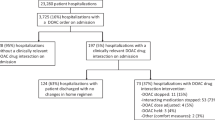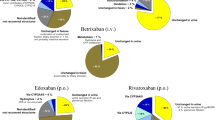Abstract
Background
Direct oral anticoagulants (DOACs) can be involved in clinical relevant drug–drug interactions (DDIs) which may compromise safe and effective use. However, assessing the clinical relevance of DDIs with DOACs and managing these interactions optimally, can be challenging in clinical practice.
Aim
To develop a practice-oriented list of potentially clinically relevant DDIs with DOACs with corresponding management plans for which it is important to screen in ambulatory care.
Method
The RAND/UCLA appropriateness method was used to develop the DOACs DDI list. In a first step a preliminary list was compiled of potentially clinically relevant DDIs per DOAC (apixaban, dabigatran, edoxaban, rivaroxaban) using five reference sources. Subsequently, a two-step modified Delphi process involving a multidisciplinary panel (n = 10) including both pharmacists and physicians with expertise in all decision-making disciplines involved in care for patients using DOACs and with diversity of practice setting, was used to reach expert agreement on a final list of DDIs with corresponding management plans.
Results
After a two-step consensus round, 71 DDIs for 20 different interacting drugs were included: five pharmacodynamic, nine pharmacokinetic inhibitor and six pharmacokinetic inducer interacting drugs. Considerations raised and discussed by the panellists were related to (1) the necessity of the interacting drug, (2) the manageability of the DDI (whether there are any alternatives), (3) the (clinical) evidence-base for the DDI and (4) the (potential) consequences of the DDI.
Conclusion
We developed a consensus list with specific and straightforward management plans on potentially clinically relevant DDIs with DOACs, for use in ambulatory care.
Similar content being viewed by others
References
Hindricks G, Potpara T, Dagres N, et al. 2020 ESC guidelines for the diagnosis and management of atrial fibrillation developed in collaboration with the European Association for Cardio-Thoracic Surgery (EACTS): The Task Force for the diagnosis and management of atrial fibrillation of the European Society of Cardiology (ESC) Developed with the special contribution of the European Heart Rhythm Association (EHRA) of the ESC. Eur Heart J. 2021;42(5):373–498.
Kozieł M, Teutsch C, Bayer V, et al. Changes in anticoagulant prescription patterns over time for patients with atrial fibrillation around the world. J Arrhythm. 2021;37(4):990–1006.
Ruff CT, Giugliano RP, Braunwald E, et al. Comparison of the efficacy and safety of new oral anticoagulants with warfarin in patients with atrial fibrillation: a meta-analysis of randomised trials. Lancet. 2014;383(9921):955–62.
Steffel J, Collins R, Antz M, et al. 2021 European Heart Rhythm Association practical guide on the use of non-vitamin K antagonist oral anticoagulants in patients with atrial fibrillation. Europace Eur Pacing Arrhythm Card Electrophysiol J Work Groups Card Pacing Arrhythm Card Cell Electrophysiol Eur Soc Cardiol. 2021;23(10):1612–76.
Capiau A, Mehuys E, Dhondt E, et al. Physicians’ and pharmacists’ views and experiences regarding use of direct oral anticoagulants in clinical practice. Br J Clin Pharmacol. 2022;88(4):1856–65.
Zhang Y, Souverein PC, Gardarsdottir H, et al. Risk of major bleeding among users of direct oral anticoagulants combined with interacting drugs: a population-based nested case-control study. Br J Clin Pharmacol. 2020;86(6):1150–64.
Komen JJ, Hjemdahl P, Mantel-Teeuwisse AK, et al. Concomitant anticoagulant and antidepressant therapy in atrial fibrillation patients and risk of stroke and bleeding. Clin Pharmacol Ther. 2020;107(1):287–94.
Holm J, Mannheimer B, Malmström RE, et al. Bleeding and thromboembolism due to drug–drug interactions with non-vitamin K antagonist oral anticoagulants-a Swedish, register-based cohort study in atrial fibrillation outpatients. Eur J Clin Pharmacol. 2021;77(3):409–19.
Wiggins BS, Dixon DL, Neyens RR, et al. Select drug–drug interactions with direct oral anticoagulants: JACC review topic of the week. J Am Coll Cardiol. 2020;75(11):1341–50.
Grymonprez M, Vanspranghe K, Steurbaut S, et al. Non-vitamin K antagonist oral anticoagulants (NOACs) versus warfarin in patients with atrial fibrillation using P-gp and/or CYP450-interacting drugs: a systematic review and meta-analysis. Cardiovasc Drugs Ther. 2021. https://doi.org/10.1007/s10557-021-07279-8.
Sennesael AL, Larock AS, Hainaut P, et al. The impact of strong inducers on direct oral anticoagulant levels. Am J Med. 2021;134(10):1295–9.
Grymonprez M, Vanspranghe K, Capiau A, et al. Impact of P-glycoprotein and/or CYP3A4-interacting drugs on effectiveness and safety of non-vitamin K antagonist oral anticoagulants in patients with atrial fibrillation: a meta-analysis. Br J Clin Pharmacol. 2022;88(7):3039–51.
Vazquez SR. Drug–drug interactions in an era of multiple anticoagulants: a focus on clinically relevant drug interactions. Blood. 2018;132(21):2230–9.
Niu J, Straubinger RM, Mager DE. Pharmacodynamic drug–drug interactions. Clin Pharmacol Ther. 2019;105(6):1395–406.
Johnell K, Klarin I. The relationship between number of drugs and potential drug–drug interactions in the elderly: a study of over 600,000 elderly patients from the Swedish Prescribed Drug Register. Drug Saf. 2007;30(10):911–8.
Papastergiou J, Kheir N, Ladova K, et al. Pharmacists’ confidence when providing pharmaceutical care on anticoagulants, a multinational survey. Int J Clin Pharm. 2017;39(6):1282–90.
Chen A, Stecker E, Warden BA. Direct oral anticoagulant use: a practical guide to common clinical challenges. J Am Heart Assoc. 2020;9(13):e017559.
Capiau A, De Backer T, Grymonprez M, et al. Appropriateness of direct oral anticoagulant dosing in patients with atrial fibrillation according to the drug labelling and the EHRA practical guide. Int J Cardiol. 2021;328:97–103.
Fitch K, Bernstein SJ, Aguilar MD, et al. The RAND/UCLA appropriateness method user’s manual. Santa Monica: RAND Corporation; 2001. ISBN 0-8330-2918-5.
Elsevier Inc. Clinical pharmacology—drug interaction report. 2021. https://www.clinicalkey.com/pharmacology/. Accessed 11 Aug 2022.
MedicinesComplete. Stockley's drug interactions. 2021. https://www.medicinescomplete.com/. Accessed 11 Aug 2022.
Health Base. Commentaren Medicatiebewaking. 2020. https://www.commentarenmedicatiebewaking.nl/. Accessed 11 Aug 2022.
Steffel J, Verhamme P, Potpara TS, et al. The 2018 European Heart Rhythm Association Practical Guide on the use of non-vitamin K antagonist oral anticoagulants in patients with atrial fibrillation. Eur Heart J. 2018;39(16):1330–93.
Li A, Li MK, Crowther M, et al. Drug–drug interactions with direct oral anticoagulants associated with adverse events in the real world: a systematic review. Thromb Res. 2020;194:240–5.
Agbabiaka TB, Wider B, Watson LK, et al. Concurrent use of prescription drugs and herbal medicinal products in older adults: a systematic review. Drugs Aging. 2017;34(12):891–905.
Bezabhe WM, Bereznicki LR, Radford J, et al. Five-year trends in potential drug interactions with direct-acting oral anticoagulants in patients with atrial fibrillation: an Australian-wide study. J Clin Med. 2020;9(11):3568.
Jou J, Johnson PJ. Nondisclosure of complementary and alternative medicine use to primary care physicians: findings from the 2012 National Health Interview Survey. JAMA Intern Med. 2016;176(4):545–6.
Andersson ML, Böttiger Y, Lindh JD, et al. Impact of the drug-drug interaction database SFINX on prevalence of potentially serious drug–drug interactions in primary health care. Eur J Clin Pharmacol. 2013;69(3):565–71.
Slight SP, Seger DL, Nanji KC, et al. Are we heeding the warning signs? Examining providers’ overrides of computerized drug–drug interaction alerts in primary care. PLoS ONE. 2013;8(12):e85071.
Acknowledgements
We would like to thank the following experts who participated in the Delphi process: Thierry Christiaens, Tine De Backer, Leen De Bolle, Sara Desmaele, An De Sutter, Dimitri Hemelsoet, Souad Moudallel, Mirko Petrovic, Annemie Somers and Ellen Van Leeuwen.
Funding
No specific funding was received.
Author information
Authors and Affiliations
Corresponding author
Ethics declarations
Conflicts of interest
The authors have no conflicts of interest to declare.
Additional information
Publisher's Note
Springer Nature remains neutral with regard to jurisdictional claims in published maps and institutional affiliations.
Supplementary Information
Below is the link to the electronic supplementary material.
Rights and permissions
Springer Nature or its licensor (e.g. a society or other partner) holds exclusive rights to this article under a publishing agreement with the author(s) or other rightsholder(s); author self-archiving of the accepted manuscript version of this article is solely governed by the terms of such publishing agreement and applicable law.
About this article
Cite this article
Capiau, A., Mehuys, E., De Bolle, L. et al. Drug–drug interactions with direct oral anticoagulants: development of a consensus list for ambulatory care. Int J Clin Pharm 45, 364–374 (2023). https://doi.org/10.1007/s11096-022-01511-7
Received:
Accepted:
Published:
Issue Date:
DOI: https://doi.org/10.1007/s11096-022-01511-7




